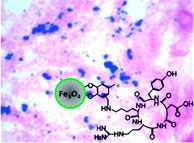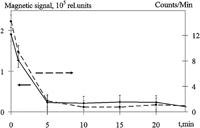2008 Archive
Static magnetic field effects: Are they real?
 Magnets have been used to relieve pain for over 4000 years. The use of magnets for pain relief in Chinese medicine dates back to about 2000 B.C., Aristotle and Plato both talked of the benefits of lodestone for pain relief, and the great physicist Michael Faraday published extensively about the healing effects of magnetic fields. Currently, millions of people worldwide use static magnetic fields in some form or other for pain relief. However, many experts believe that there are no physical or biological mechanisms to explain any value of these devices for the relief of pain and no clinical evidence to support their use. In the journal Medical Physics, this topic was discussed in their Point/Counterpoint article in July 2008. Link.
Magnets have been used to relieve pain for over 4000 years. The use of magnets for pain relief in Chinese medicine dates back to about 2000 B.C., Aristotle and Plato both talked of the benefits of lodestone for pain relief, and the great physicist Michael Faraday published extensively about the healing effects of magnetic fields. Currently, millions of people worldwide use static magnetic fields in some form or other for pain relief. However, many experts believe that there are no physical or biological mechanisms to explain any value of these devices for the relief of pain and no clinical evidence to support their use. In the journal Medical Physics, this topic was discussed in their Point/Counterpoint article in July 2008. Link.
 Researchers create smallest nanoparticles to be used with MRI
Researchers create smallest nanoparticles to be used with MRI
Researchers from Brown University have created the smallest magnetic nanoparticles to date that can be used to help find clusters of cancerous cells, and they emit a signal for MRI detection. Including coating, the nanoparticles have an overall diameter of ~8.4 nm and are stable in physiological conditions. For more information, check out the JACS article at http://pubs.acs.org/cgi-bin/abstract.cgi/jacsat/asap/abs/ja802003h.html.
Experiment for Children
 Follow these step by step instructions to create your own ferrofluid. The instructions were written for middle school students so they are clear and detailed.
Follow these step by step instructions to create your own ferrofluid. The instructions were written for middle school students so they are clear and detailed.
Most Accessed Article from the Journal on Molecular Pharmaceutics
 One of our own has made it into the top 5 most cited articles in the journal "Molecular Pharmaceutics". We congratulate Tapan Jain and his co-authors to their interesting work!
One of our own has made it into the top 5 most cited articles in the journal "Molecular Pharmaceutics". We congratulate Tapan Jain and his co-authors to their interesting work!
Iron Oxide Nanoparticles for Sustained Delivery of Anticancer Agents
Joint European Magnetic Symposia
JEMS'08 will be held in Ireland at Trinity College Dublin, from September 14-19,
2008. Members of the international scientific and engineering
communities interested in recent developments in magnetism and related
technology are welcome to participate the Conference. Plenary and
semi-plenary lectures aimed at the general technical audience are a
highlight of the meeting. Reports of new research results will be organized
in a series of independent symposia, listed below. A special tutorial
session aimed at graduate students and young engineers will be held on 14th.
This year we are also pleased to announce the special keynote leactures by two nobel laureate 2007 Peter Gruenberg, Julich Germany: From Spinwaves to Giant Magnetoresistance
and beyond
Albert Fert, CNRS/Thales Orsay, France: The present and the future of
spintronics. More Information
New Approach to Prevent Non-Specific Binding in Magnetic ELISA Assay

A new fluidic design combined with an original strategy of manipulating magnetic beads in order to reduce assay noise in bead-based microfluidic ELISA without the need for prior channel pre-treatment has been reported by Herrmann et al. The novelty of the system relies on the physical separation of the immune complex formation phase and the enzymatic reaction phase into two independent networks of channels. These networks are linked by fluidic bridges, whose openings are controlled by pressure valves, and through which the beads are magnetically transferred. Click here for details.
Proceedings for the 2006 Scientific and Clinical Applications of Magnetic Carriers Meeting
 After every "Magnetic Carrier Meeting", we publish a book or a special issue that contains the most-up-to date research in our area. A special issue of the "Journal of Magnetism and Magnetic Materials" has appeared on March 15, 2007 as volume 311 and contains 97 original peer-reviewed papers published after the 2006 meeting. Have a look at the Table of Contents.
After every "Magnetic Carrier Meeting", we publish a book or a special issue that contains the most-up-to date research in our area. A special issue of the "Journal of Magnetism and Magnetic Materials" has appeared on March 15, 2007 as volume 311 and contains 97 original peer-reviewed papers published after the 2006 meeting. Have a look at the Table of Contents.
Purchase a copy of this years proceedings (60 Euros including shipping):
Quantitative Magnetic Nanoparticle Detection by Nonlinear Magnetization
 Click to enlarge. |
Petr and Max Nikitin developed a highly sensitive and quantitative method of measuring magnetic nanoparticles in biological tissues and blood. The new system compared very well to radioactive Fe-59 measurements in a rat performed by Torno, Chen and Rosengart (see Figure). Their sensitivity is good enough to measure just a few nanograms of magnetic nanoparticles in 0.1 ml volume! Read more about it in the Journal of Applied Physics at http://dx.doi.org/10.1063/1.2830947.
Korean Institute (KAIST) Fires Star Scientist: Scientific Fraud
KAIST has indefinitely suspended bioscience professor Tae Kook Kim for the fabrication of data in two papers. Tae Kook Kim, of the Korea Advanced Institute of Science and Technology (KAIST) in Daejeon, had reported a new method for imaging living cells that used magnetized nanoparticles (J. Won et al. Science 309, 121–125 ; 2005, and J. Won et al. Nature Chem. Biol. 2, 369–374 ; 2006).
For more information, check the final decision in Science published on April 24, 2009.
Magnetic Nanoparticles for Microfluidic Separations and Assays
 Click to enlarge. |
Exploring Nanomagnetics to Fight Disease
 Don Ingber, MD, PhD, and Robert Mannix, PhD, at Children's Hospital (Boston) working with Mara Prentiss, PhD, a Harvard University physicist, are exploring how nanomagnetics might fight disease at the single-cell level. Researchers have found nanobeads can be magnetized, and 'pull' cell receptors into large clusters, mimicking what happens when drugs or other molecules bind to them. The nano-magnets also trigger a cell's biochemical signals and impact internal functions. Details
Don Ingber, MD, PhD, and Robert Mannix, PhD, at Children's Hospital (Boston) working with Mara Prentiss, PhD, a Harvard University physicist, are exploring how nanomagnetics might fight disease at the single-cell level. Researchers have found nanobeads can be magnetized, and 'pull' cell receptors into large clusters, mimicking what happens when drugs or other molecules bind to them. The nano-magnets also trigger a cell's biochemical signals and impact internal functions. Details
Magnetic Control of Liquid Colour
Researchers at the University of California have discovered it is possible to control the colour of iron oxide particles suspended in water. Varying the strength of an external magnetic field changes the arrangement of the iron oxide particles causing this effect. This research may have important effects on current and future electronic devices including electronic displays and magnetic rewrittable paper/ink.

Check out the full story and movie Here.
Magnetic microchip-based detection of magnetic particles
 Mark Tondra wrote an interesting article about the use of microchip-based detection of magnetic particles. He reviews existing magnetic bioassay detection applications and presents possible directions for new development in the detection of immobilized magnetic-assay labels. In addition, his article examines concepts relating to the integration of magnetic detection in microfluidic systems. More...
Mark Tondra wrote an interesting article about the use of microchip-based detection of magnetic particles. He reviews existing magnetic bioassay detection applications and presents possible directions for new development in the detection of immobilized magnetic-assay labels. In addition, his article examines concepts relating to the integration of magnetic detection in microfluidic systems. More...
Exciting New Equipment: Magnetic Nanoparticle Analyzer
 Biochemical assays based on magnetic nanoparticles as markers offer a very sensitive, fast detection of chemicals in biology and biochemistry. The magnetic
nanoparticle analyzer represents a new comfortable laboratory tool for the sensitive quantitative detection and the fast and comprehensive characterization of magnetic nanoparticles as markers for quality control in biological and biochemical laboratories.
Biochemical assays based on magnetic nanoparticles as markers offer a very sensitive, fast detection of chemicals in biology and biochemistry. The magnetic
nanoparticle analyzer represents a new comfortable laboratory tool for the sensitive quantitative detection and the fast and comprehensive characterization of magnetic nanoparticles as markers for quality control in biological and biochemical laboratories.
For more information, please check here.
Biomagnetic sensors in the press
A team led by Dr. Richard Larson of the University of New Mexico Cancer Research and Treatment Center and Ed Flynn of Senior Scientific LLC is investigating the potential of bio-magnetic sensors for early detection of disease or organ rejection.
The super-sensitive sensors can detect cancer cells in far smaller concentrations than current technology can — meaning earlier detection and treatment, they say.
"My bottom line is it's much more sensitive, (spotting) fewer cells at a much earlier stage of the disease," Larson said. "You could detect cancer or Alzheimer's noninvasively. We can't do that right now." Read more...
Japan to launch long-distance commercial service of super-fast magnetic trains
 Magnetic trains zooming at a landscape-blurring 500 kilometers (310 miles) an hour will connect Tokyo and Nagoya by 2025, one of Japan's biggest railway operators said Friday.
Magnetic trains zooming at a landscape-blurring 500 kilometers (310 miles) an hour will connect Tokyo and Nagoya by 2025, one of Japan's biggest railway operators said Friday.
The new magnetically levitated, or "maglev," trains would slash the 100-minute travel time down the country's busiest transportation corridor and are envisioned as a successor for Japan's iconic bullet trains, or shinkansen, first introduced to the world in 1964.
Currently, China is the only country running a commercial high-speed magnetic levitation train service, running from Shanghai's financial district to its main international airport.
The line will be operated by Central Japan Railway Co., known for its pointy-nosed white and blue shinkansen. Skimming over a guideway on powerful magnetic fields without touching the track, maglevs are among the world's fastest trains, and Japan's has clocked a world record speed of up to 581 kilometers (360 miles) per hour.
More information about maglev trains is available through Wikipedia at http://en.wikipedia.org/wiki/Maglev_train.


 Photo of the Month Archive
Photo of the Month Archive